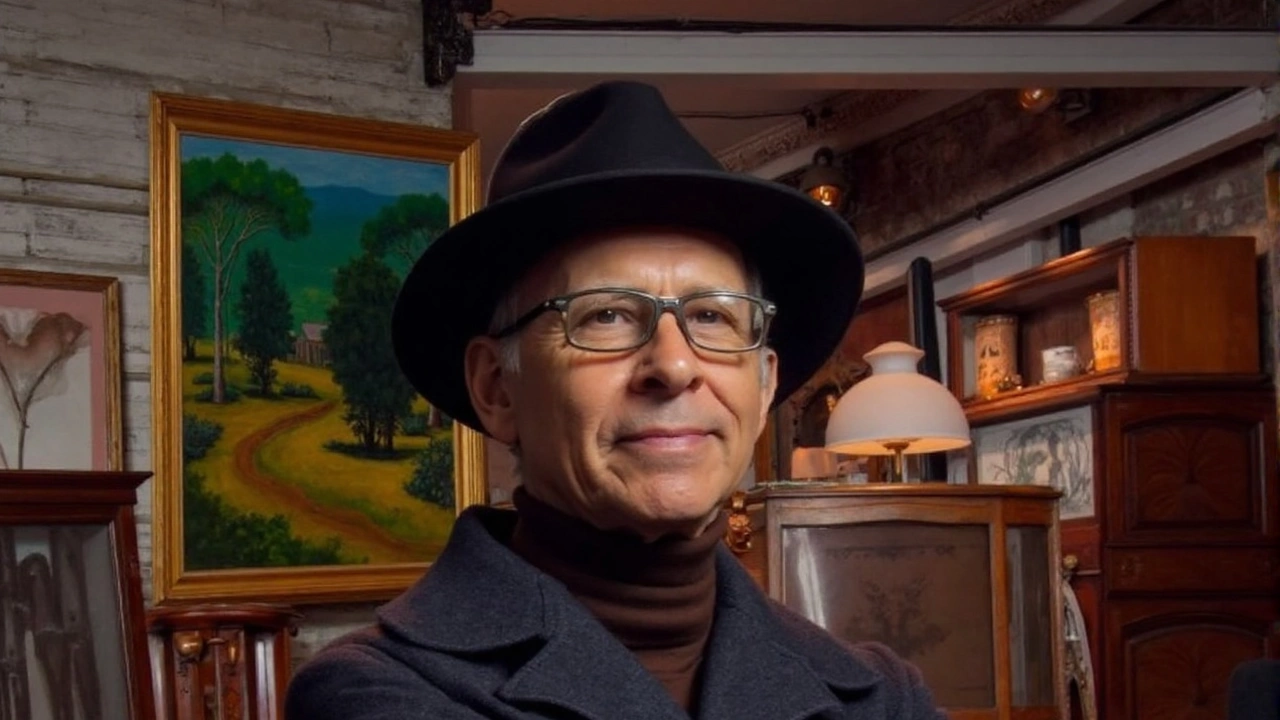From care homes to the saleroom
Ronnie Archer Morgan didn’t learn about antiques in a classroom. He learned between haircuts and lunch breaks. Before millions knew him from BBC’s Antiques Roadshow, he was a young man finding his way after a rough start: born in 1950 to a Sierra Leonean mother, his father died in a car crash before he was born, and he spent much of his childhood in residential care and foster homes. That early instability didn’t define him, but it did fuel a stubborn curiosity that became his trademark.
He left school at 17 with no clear plan. He tried technical drawing, model making, DJing, a stint managing a boutique in Greece, even hairdressing. None of it looked like a path to the antiques world. But in the 1970s, while working as a hairdresser at Vidal Sassoon, he started wandering into nearby antique shops on his breaks. He’d buy something that caught his eye, bring it back to the salon, and watch as celebrity clients—Felicity Kendal, Richard Briers, Count Basie, Lena Horne, Dudley Moore, Hayley Mills, Tommy Cooper—snapped up his finds. It was a side hustle that quickly became a calling.
That habit—spot, buy, learn—set his method. He gravitated to unfamiliar objects. If he didn’t know what something was, he bought it, then made it his business to find out. He took stones to gemmologists. He carried metalwork to the Victoria and Albert Museum’s study rooms. He spent hours in the Pitt Rivers, the Horniman, and the British Museum, comparing forms, materials, and marks. He didn’t have a degree, but he assembled a personal syllabus: how to date a clasp, how a hinge should feel, why a patina matters. He treated every object like a teacher.
That self-taught streak paid off in a way few saw coming. Sotheby’s asked him to consult on a sale of wristwatches—a category then starting to separate itself from the general jewellery trade. He had spotted a gap: watches weren’t just timekeepers, they were design, engineering, and status in a small, collectible package. His eye for detail and his calm read of condition and originality made him useful to serious buyers. Work followed, and he opened a gallery in Knightsbridge.
The welcome wasn’t warm at first. The British antiques world in those years was clubby and mostly white. He walked in as a Black dealer in a leather jacket and a baseball cap. Some dealers didn’t quite know what to do with that. He stuck with it. He learned the rooms, the rhythms of fairs, the value of a good provenance and a better network. In time, the same people who doubted him were asking for his opinion.
Ask him what he loves and he’ll say vintage watches, wallets, cigar cases, and luggage. Those categories are tactile. You feel the quality in the weight of a case, the snap of a clasp, the leather’s grain. Watches tell stories—from tool pieces made for pilots to elegant dress watches that crossed dinner tables and decades. Wallets and cigar cases trace changing tastes and materials. Luggage shows craft at scale: canvas and leather shaped to survive travel and still look sharp. He trusts his taste first and the market second. When he put on exhibitions built around what he liked, the pieces sold fast and sometimes set off small trends. That’s been his rhythm: collect, edit, show, and let buyers catch up.
In 2011, he joined Antiques Roadshow. Viewers know the setup: people bring in family objects, and experts weigh in with context and, sometimes, a number that makes jaws drop. Archer Morgan does more than value. He translates. He explains why a hinge is right for the period, how an engraving style dates a piece, or why modest wear can be a good sign. He brings a calm, plain-spoken tone to objects that carry memory—war mementos, heirloom jewellery, travel pieces that crisscrossed continents. His segments often land not because of the figure at the end, but because he shows what looking closely can reveal.
That focus on respect—for the object and the story—comes from experience. Growing up, he faced abuse and racism. Then came a turning point: a foster family that gave him what he calls his first real feeling of being valued. He credits Molly Hode, whom he called “Mummy Hode,” with saving his life. That sense of being seen shows up in the way he handles delicate histories on television and in his insistence that value isn’t just money; it’s meaning, craft, and context.
His book, Would It Surprise You to Know...?, tracks that line from a hard childhood to a life built on curiosity and graft. It’s not a neat arc. It’s trial and error, shops and study rooms, small wins that add up. For readers, the takeaway is simple: a tough start doesn’t lock your future. Knowledge, even when self-directed, compounds. And when you find people who back you, it changes everything.
For anyone starting out in collecting, his playbook is straightforward: handle the real thing, ask questions, and buy less but better. Museum visits aren’t chores; they’re shortcuts. Compare examples. Pay attention to detail, especially condition and originality. Avoid chasing a name for the name’s sake if the object itself doesn’t speak to you. Price follows quality more often than the other way around.
- Start with categories you actually enjoy—watches, small leather goods, travel pieces, whatever pulls you in.
- Learn how to read wear. Honest patina can add charm; damage that kills function usually doesn’t.
- Keep notes. What you handled, what you passed on, and why. Your eye gets sharper when you track it.
- Build relationships with dealers and specialists. Good advice is worth more than a bargain.
The market around him has shifted. Sustainability made second-hand mainstream again. Repair culture is back, and the idea of holding and using well-made objects is appealing in a world of fast fashion and short lifespans. Watches now sit at the crossroads of design, engineering, and investment. Luggage and travel accessories carry a nostalgia for the golden age of travel, but they’re also practical, and some pieces are built better than anything new.
Through all the trends, Archer Morgan keeps the same filter: do I like it, and does it have integrity? That’s why his exhibitions worked. He curated by eye, not by algorithm. Buyers followed because they trusted that eye. When a dealer’s taste is consistent, collectors feel it—piece to piece, show to show.
His path also widened the field. For years, Black dealers were rare in the UK antiques trade, and seeing him in a central BBC slot mattered. It challenged assumptions about who gets to speak for culture and craftsmanship. Younger viewers and new collectors saw someone who didn’t come up through the usual channels, and who didn’t hide that fact. That kind of representation doesn’t fix an industry, but it does open a door.
There’s another reason his story sticks. It’s built on curiosity. He bought what he didn’t understand, then earned the understanding. He sought out experts, but he didn’t outsource judgment. He learned by holding things, looking closely, and asking better questions the next time. That’s a skill that transfers beyond antiques—to any field where details matter and taste has to be developed, not borrowed.
These days, he’s still the same: alert to the odd and the overlooked. He’ll pick up a wallet because the stitching is right, or a travel case because the handle’s wear tells a truthful story. He knows a good watch when he sees one, but he also knows when to walk away. As trends loop and prices surge, he stays steady. The goal isn’t to chase the hottest category; it’s to build a collection that feels like you—and stands up to scrutiny.

Antiques Roadshow and the power of a self-taught eye
On the Roadshow, the format rewards clarity. Archer Morgan breaks down why an object matters in a way that makes a viewer think, I can learn to see that. He’ll point to details that anyone can spot once they know where to look: how a hinge is cut, how a hallmark is struck, why a dial’s typography gives away the era. He strips away jargon without dumbing anything down. That’s hard to do on camera, and it’s why people remember his valuations even when they forget the numbers attached.
His specialties—vintage watches, wallets, cigar cases, and luggage—also suit television. They’re intimate, often handled for decades, and they hold layers of personal history. A watch is a gift, a milestone, a daily companion. A travel case is a proxy for movement and memory. He’s good at reading those layers without drifting into sentimentality. He respects the object and whatever family story comes with it.
The effect is wider than one TV slot. When a mainstream audience sees careful, hands-on connoisseurship, it changes the way they approach their own belongings. People start checking hallmarks, learning to store leather, winding watches properly, and, in many cases, fixing rather than tossing. That’s a quiet cultural shift—one that makes craft and care a normal part of everyday life.
Archer Morgan’s story is also a reminder that the antiques world, for all its gatekeeping, is still open to people who show up with patience, taste, and integrity. You don’t need perfect credentials to build expertise. You do need to put in hours, take a few risks, and accept that sometimes you’ll buy the wrong thing and learn the right lesson.
He’s been open about the role his foster family played in making that possible. Feeling valued gave him the confidence to value things properly—to say this is well made, this is not, and to stand by that call. That kind of steady judgment is what buyers want, what viewers respond to, and what keeps a career like his moving forward decades after it began in a hair salon with an inquisitive glance at a shop window.
